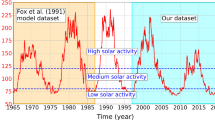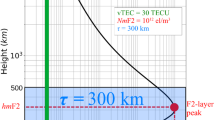Abstract
Variations of the upper boundary of the ionosphere (UBI) are investigated based on three sources of information: (i) ionosonde-derived parameters: critical frequency foF2, propagation factor M3000F2, and sub-peak thickness of the bottomside electron density profile; (ii) total electron content (TEC) observations from signals of the Global Positioning System (GPS) satellites; (iii) model electron densities of the International Reference Ionosphere (IRI*) extended towards the plasmasphere. The ionospheric slab thickness is calculated as ratio of TEC to the F2 layer peak electron density, NmF2, representing a measure of thickness of electron density profile in the bottomside and topside ionosphere eliminating the plasmaspheric slab thickness of GPS-TEC with the IRI* code. The ratio of slab thickness to the real thickness in the topside ionosphere is deduced making use of a similar ratio in the bottomside ionosphere with a weight Rw. Model weight Rw is represented as a superposition of the base-functions of local time, geomagnetic latitude, solar and magnetic activity. The time-space variations of domain of convergence of the ionosphere and plasmasphere differ from an average value of UBI at ∼1000 km over the earth.
Analysis for quiet monthly average conditions and during the storms (September 2002, October–November 2003, November 2004) has shown shrinking UBI altitude at daytime to 400 km. The upper ionosphere height is increased by night with an ‘ionospheric tail’ which expands from 1000 km to more than 2000 km over the earth under quiet and disturbed space weather. These effects are interposed on a trend of increasing UBI height with solar activity when both the critical frequency foF2 and the peak height hmF2 are growing during the solar cycle.
Similar content being viewed by others
References
Bilitza, D., 2001, International reference ionosphere 2000, Radio Sci. 36, 261–275.
Carpenter, D.L., and C.G. Park, 1973, On what ionospheric workers should know about the plasmapause-plasmasphere, Rev. Geophys. Space Phys. 11, 133–154.
CCIR, 1990, Atlas of ionospheric characteristics, Report 340, Radiocommunication Sector Recommendation 434-4, ITU, Geneva.
Davies, K., and X.M. Liu, 1991, Ionospheric slab thickness in middle and low latitudes, Radio Sci. 26, 4, 997.
Deminova, G.F., V. M. Shashunkina and E.E. Goncharova, 1998, A global empirical model of effects of large-scale internal gravity waves in the nighttime ionosphere, J. Atmos. Solar-Terr. Phys. 60, 2, 227–245.
Gallagher, D.L., P.D. Craven and R.H. Comfort, 2000, Global core plasma model, J. Geophys. Res. 105, A8, 18,819–18,833.
Gringauz, K.I., and V.V. Bezrukikh, 1976, Asymmetry of the Earth’s plasmasphere in the direction noon-midnight from Prognoz and Prognoz-2 data, J. Atmos. Terr. Phys. 38, 1071–1076.
Gulyaev, R.A., and T.L. Gulyaeva, 1984, On illuminating the ionosphere by sunlight during nighttime, Geomagn. Aeron. 24, 2, 347–348.
Gulyaeva, T.L., 2003, Variations of the half-width of the topside ionosphere according to the observations by space ionosondes ISIS1, ISIS2, and IK19, Intern. J. Geomagn. Aeron. 4, 3, 201–207.
Gulyaeva, T.L., 2004, Incorporation of topside half peak density anchor point in IRI, Adv. Space Res. 34, 9, 1993–1997.
Gulyaeva, T.L., and B. Jayachandran, 2004, Expanding ionosphere during geomagnetic storms, Geomagn. Aeron. 44, 3, 348–353.
Gulyaeva, T.L., and I. Stanislawska, 2005, Night-day imprints of ionospheric slab thickness during geomagnetic storms, J. Atmos. Solar-Terr. Phys. 67, 1307–1314.
Gulyaeva, T.L., X. Huang and B.W. Reinisch, 2002, Plasmaspheric extension of topside electron density profiles, Adv. Space Res. 29, 6, 825–831.
Ho, C.M., A.J. Mannucci, U.J. Lindqwister, X. Pi and B.T. Tsurutani, 1996, Global ionosphere perturbations monitored by the worldwide GPS network, Geophys. Res. Lett. 23, 3219–3222.
Jayachandran, B., T.N. Krishnankutty and T.L. Gulyaeva, 2004, Climatology of ionospheric slab thickness, Ann. Geophys. 21, 1, 25–34.
Kersley, L., and J.A. Klobuchar, 1979, Storm associated protonospheric depletion and recovery, Planet. Space Sci. 28, 453–458.
Stanislawska, I., G. Juchnikowski, R. Hanbaba, H. Rothkaehl, G. Sole and Z. Zbyszynski, 2000, COST 251 recommended instantaneous mapping model of ionospheric characteristics — PLES, Phys. Chem Earth C 25, 4, 291–294.
Titheridge, J.E., 1973, The slab thickness of the mid-latitude ionosphere, Planetary and Space Science 21, 1775–1793.
Tsurutani, B., A. Mannucci, B. Iijima and M.A. Abdu, 2004, Global dayside ionospheric uplift and enhancement associated with interplanetary electric fields, J. Geophys. Res. 109, A08302, doi:10.1029/2003JA010342.
Author information
Authors and Affiliations
Rights and permissions
About this article
Cite this article
Gulyaeva, T.L. Configuration of the upper boundary of the ionosphere. Acta Geophys. 55, 253–266 (2007). https://doi.org/10.2478/s11600-007-0007-5
Received:
Accepted:
Published:
Issue Date:
DOI: https://doi.org/10.2478/s11600-007-0007-5




